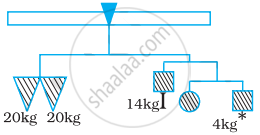Advertisements
Advertisements
Question
The sum of three consecutive integers is 5 more than the smallest of the integers. Find the integers.
Solution
Let one number be x
Then, the next two consecutive numbers will be x + 1 and x + 2
Sum of these three numbers = x + (x + 1) + (x + 2) = 3x + 3
According to the question,
3x + 3 = x + 5
⇒ 3x – x = 5 – 3 ......[Transposing x to LHS and 3 to RHS]
⇒ 2x = 2
⇒ `(2x)/2 = 2/2` .......[Dividing both sides by 2]
⇒ x = 1
∴ Hence, the numbers are 1, 1 + 1, 1 + 2 i.e., 1, 2, 3.
APPEARS IN
RELATED QUESTIONS
Set up equation and solve them to find the unknown number in the following case:
Ibenhal thinks of a number. If she adds 19 to it and divides the sum by 5, she will get 8.
The sum of three times a number and 11 is 32. Find the number.
In a Mathematics quiz, 30 prizes consisting of 1st and 2nd prizes only are to be given. 1st and 2nd prizes are worth ₹ 2000 and ₹ 1000, respectively. If the total prize money is ₹ 52,000 then show that:
The number of 1st prizes are ______ and the number of 2nd prizes are ______.
13 subtracted from twice of a number gives 3.
One-fifth of a number is 5 less than that number.
Six times a number is 10 more than the number.
If 1 is subtracted from a number and the difference is multiplied by `1/2`, the result is 7.
In a school, the number of girls is 50 more than the number of boys. The total number of students is 1070. Find the number of girls.
Each of the 2 equal sides of an isosceles triangle is twice as large as the third side. If the perimeter of the triangle is 30 cm, find the length of each side of the triangle.
The given figure represents a weighing balance. The weights of some objects in the balance are given. Find the weight of each square and the circle.

